Last week, the Federal Reserve sent financial commentators and traders into a frenzy. It announced that, although it had left the federal funds rate target unchanged, it is ready to lower the rate aggressively if economic activity does not improve. Also, the central bank expressed concern that a strong downtrend in the growth momentum of price inflation, as depicted by the CPI, less food and energy, could pose a threat to the economy.
The yearly rate of increase in the CPI, less food and energy, fell to 1.7% in March from 1.9% in February and 2.4% in March last year.
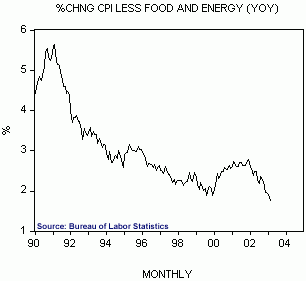
It seems that the Fed is signalling to the market that it is shifting from its traditionally advertised role of fighting inflation to fighting deflation. Most experts, including Fed officials, are of the view that deflation is a much greater menace than inflation and therefore deserves special attention.
It is held that a fall in prices, which is termed deflation, causes consumers to postpone their buying of goods and services. In short, if people hold on to their money during deflation its purchasing power will increase and this will enable them to buy more goods some time in the future. It is for this reason, so it is held, that people choose to spend less once prices are falling.
It is further believed that since consumer spending is almost 70% of GDP this means a cut in consumer spending would slow down the economy. A slower economy in turn, would cause businesses to retrench labor, increasing unemployment and slowing consumer spending further. All this intensifies the economic slump and depresses prices further. According to this way of thinking, falling prices set in motion a vicious downward spiral that spreads economic havoc.
The usual examples cited are the U.S. 1930's Great Depression and the current Japanese economic slump. In the U.S. between January 1930 and May 1933 the consumer price index (CPI) fell by 26.3%. This fall in the CPI was accompanied by a sharp decline of 47% in industrial production between January 1930 and July 1932.
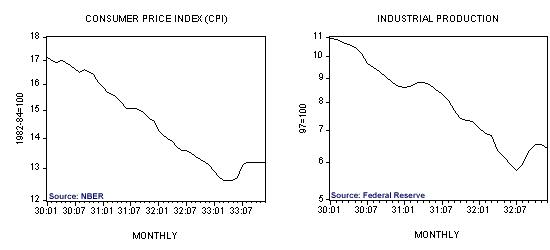
Likewise in Japan: the CPI, which stood at 101.63 in November 98, fell to 98.3 by March 2003 representing a fall of 3.3%. The fall in the CPI was accompanied by depressed economic activity with industrial output now well below the long-term trend for a fifth consecutive year.

Based on the view that price deflation is bad news, many experts suggest that the Fed should adopt a policy of targeting inflation. According to this logic, while price deflation causes consumers to postpone buying, which in turn leads to economic depression, price inflation leads to the exact opposite. Hence by targeting price inflation the central bank could influence consumer buying and therefore general economic activity. The remedy for an economic slump brought about by price deflation is inflation, or so it is held.
But is it true that a fall in price inflation is such bad news? For example, in the U.S. from 1880 to 1896 wholesale prices fell on average by 1.8% per annum. Yet during this period we didn't observe a calamity, on the contrary income was growing at 5% per annum.1
Moreover, if a fall in prices causes people to postpone their buying, why wasn't this the case with regard to personal computers? Computer sales between 1992 and February 2003 increased by 127%, notwithstanding the fact that prices of personal computers fell by 80% during this period.
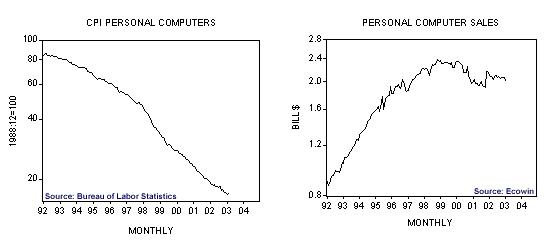
Also, between January 1992 and February 2003 the prices of appliances fell by over 20% while sales of appliances during this period increased by 129%.
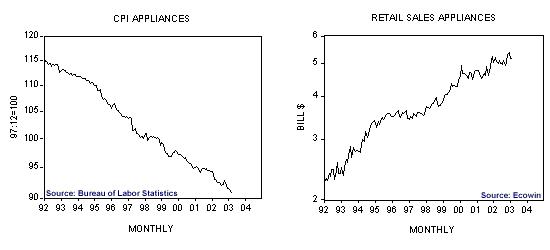
As such, changes in prices do not set in motion economic conditions but rather changes in prices are the manifestation of economic conditions. Thus for a given stock of money and an expanding production of goods and services, i.e. an expansion in real wealth, prices will develop a declining tendency. Falling prices, then, are the manifestation of the fact that the holders of dollars can now acquire a greater amount of goods and services.
According to Murray Rothbard,
Improved standards of living come to the public from the fruits of capital investment. Increased productivity tends to lower prices (and costs) and thereby distribute the fruits of free enterprise to all the public, raising the standard of living of all consumers. Forcible propping up of the price level prevents this spread of higher living standards.2
Prices will also develop a declining tendency on account of the bursting of the monetary bubble. In other words, once the bubble is burst this undermines various nonwealth-generating activities that sprang up on the back of prior monetary pumping. Note however, that this fall in prices is welcome news because the fall indicates that the diversion of real wealth from productive activities was arrested. In short, a fall in prices is indicative that the healing of the economy has begun.
On this Mises wrote,
As soon as the depression appears, there is a general lament over deflation and people clamor for a continuation of the expansionist policy. . . . Every firm is intent upon increasing its cash holdings, and these endeavors affect the ratio between the supply of money (in the broader sense) and the demand for money (in the broader sense) for cash holding. This may be properly called deflation. But it is a serious blunder to believe that the fall in commodity prices is caused by this striving after cash holding. The causation is the other way around. Prices of the factors of production—both material and human—have reached an excessive height in the boom period. They must come down before business can become profitable again. The entrepreneurs enlarge their cash holding because they abstain from buying goods and hiring workers as long as the structure of prices and wages is not adjusted to the real state of the market data. Thus any attempt of the government of the labor unions to prevent or to delay this adjustment merely prolongs the stagnation.3
It follows then that a fall in prices, which is labelled as price deflation, is always good news.
The Fed may have painted itself into a corner
Despite all the attempts that the Fed is likely to make in order to inflate the economy there is a possibility that it may fail. Why is that so? The main reason is that the current aggressive loose monetary policy, in addition to previous loose monetary policies, may have severely weakened the pool of real funding—the heart of economic growth. Various indications raise the likelihood that this pool is in trouble. For instance the income-to-consumption ratio is in free fall. In fact the fall in this ratio is currently much steeper than during the Great Depression.

Moreover, despite the aggressive lowering of interest rates by the Fed industrial production has been below its long-term trend for almost two years.

If the pool of real funding is in trouble, then the economy is likely to struggle in the months ahead. This, we suggest, raises the likelihood that banks will slow down their expansion of lending. Consequently, this will make it much harder for the Fed to inflate. Another important disincentive to lend that is currently emerging is a falling interest rate return for a given risk. The looser interest rate stance of the Fed not only undermines the sources of real economic growth but also lowers banks incentives to lend as a result of a growing risk per unit of reward.4
To put it briefly, higher risk requires higher interest returns on loans. However, on account of loose monetary policy, which depresses interest rates to extremely low levels, the incentive for banks to bear risk diminishes. Once bank lending falls, fewer deposits are generated and hence banks' demand for reserves falls.
Obviously then, the central bank's pumping of reserves will not be able to lift bank lending—it will only depress interest rates further. Eventually the central bank is forced to lower its monetary pumping.
This chain of events is already taking place in Japan. Thus on account of real economic factors, coupled with the zero interest rates, bank lending remains depressed.

Furthermore, after rising to 44.1% in July 2001 the yearly rate of growth of the Bank of Japan's (BOJ) monetary pumping, as depicted by the central bank's balance sheet, fell to -3.4% in April.
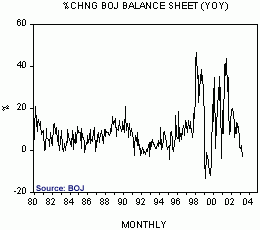
In other words, what we are currently observing in Japan is that the facts of reality are forcing the central bank to lower its monetary pumping.
For the time being, U.S. bank lending remains buoyant. The yearly rate of increase of commercial bank combined consumer, business and real estate loans jumped to 8% in April from 7.7% in March. However, a further weakening in economic activity runs the risk that the growth momentum of lending will follow suit. Moreover, if economic conditions were to deteriorate, a further loosening in the Fed's interest rate stance is likely to diminish banks' incentive to lend.
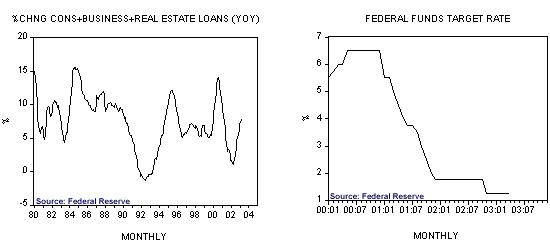
Incidentally, this may already be emerging. The main driving force behind commercial banks' still buoyant lending is real estate loans. The yearly rate of increase in these loans climbed to 17.2% in April from 16.7% in March. However, commercial bank loans excluding real estate lending fell year-on-year in April by 2.5% after a fall of 2.6% in the previous month. This was the 19th consecutive monthly decline. With the likely bursting of the real estate bubble we suspect that real estate loans will also follow suit and overall bank lending will come under pressure.

Some experts are of the view that even if commercial banks curtail their lending the Fed could still revive monetary pumping and the economy by employing the "helicopter money" approach, i.e., by mailing every citizen in the U.S. a given amount of money. The increase in money not only will boost consumption expenditure but will also weaken the dollar exchange rate thereby giving a boost to exports, or so it is held. It is also suggested that the Fed could aggressively lower long-term interest rates in order to boost business expenditure on capital goods.
But any attempt to implement this type of policy will only result in more distortions and retard the U.S. economy for many years. Furthermore, before one can consider exporting goods one must produce these goods. However, how is it at all possible to boost exports while monetary pumping is diluting the sources of real wealth generation? After all, if currency depreciation could fix economic growth then by now poverty worldwide would have been eradicated.
But, the way things currently stand, as far as economic thinking is concerned, it would not be surprising that if the economy and core price indices were to weaken further the Fed would continue to loosen its monetary stance in the months ahead.
- 1Joseph Salerno. “An Austrian Taxonomy of Deflation” Mises Institute. Jan 19, 2002).
- 2Murray N. Rothbard. [1963] 1990. "What has Government done to our money?" P. 17, Mises Institute.
- 3Ludwig von Mises. 1966. Human Action, Contemporary Books. 3rd revised edition p 568–9.
- 4Murray N. Rothbard. 2003. A History of Money and Banking in the United States, Mises Institute, p. 295.

